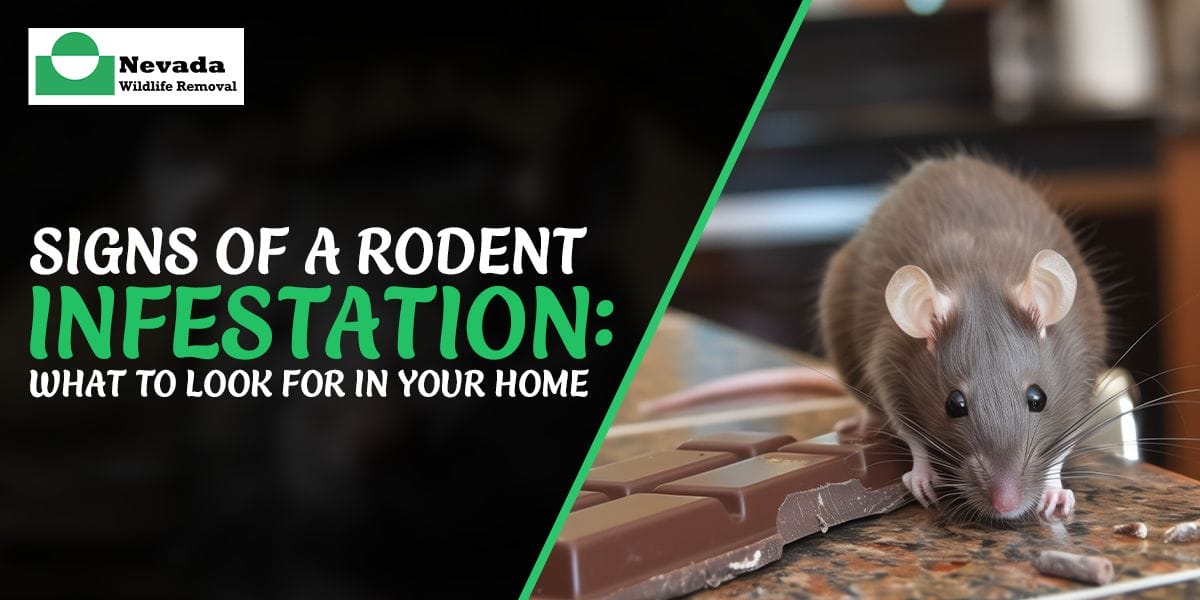Spotting the early signs of rodent infestation can save you from serious damage and health risks. Rodents don’t just snack on food; they chew wires, spread bacteria, and leave behind foul odors. With Nevada Wildlife Removal guiding you through rodent awareness, you can explain the signs in detail and how to act quickly before the problem spreads.
Why Recognizing Rodent Infestation Early Matters?
Rodents are more than pests. They bring health concerns, cause fire hazards by chewing wires, and ruin your property. Identifying the rodent problem in the house in its early stages is important to stop a small issue from becoming a costly crisis.
Detailed Signs of Rodent Infestation
The most common red flags every homeowner should watch for:
1. Droppings Around the House
One of the most obvious signs of rats in the house is the presence of droppings. Rat droppings are larger (about ½ inch) with blunt ends, while mouse droppings are smaller, resembling rice grains. Finding droppings in cupboards, under sinks, or near food storage indicates active rodent traffic.
Fresh droppings are dark and moist, while old ones appear dry and crumbly. This detail helps you gauge how recent the activity is.
2. Gnaw Marks and Chewed Items
Rodents constantly gnaw to keep their teeth from growing too long. If you spot chewed electrical wires, wooden furniture, or torn packaging, it is a warning sign of rat infestation in the house.
Smaller, finer chew marks usually come from mice, while larger, rougher ones point to rats. Chewing on electrical wiring is especially dangerous since it can lead to short circuits or even fires.
3. Strange Noises at Night
Rodents are nocturnal, so nighttime is when they are most active. If you hear scratching, scurrying, or squeaking sounds coming from walls, attics, or ceilings, that is a sign of nesting. These noises typically get louder as the infestation grows. Ignoring them only allows the colony to expand and worsen the mice problem in the house.
4. Foul or Musky Odors
Another subtle but strong indicator is odor. A rodent problem in the house comes with a distinct, musty smell. This comes from rodent urine, droppings, or even dead rodents trapped inside walls. The smell lingers even after cleaning and becomes stronger in areas of high activity.
If your pets keep sniffing or scratching at specific spots, they may be detecting rodents you can’t see.
5. Nesting Materials in Hidden Areas
Rodents like to build nests in dark, undisturbed spaces. If you discover shredded paper, cloth, insulation, or dried plant material tucked into corners, it points to nesting behavior. These nests usually appear near food sources or hidden cavities inside walls.
Spotting nests means the rodents aren’t visiting; they are living inside your home, which calls for professional rodent removal services immediately.
6. Grease Marks and Tracks
When rodents travel along walls or floors, their oily fur leaves behind greasy smudges or dark streaks. Repeated movement creates clear “runways” in dusty areas like basements or attics.
You may also notice tiny footprints or tail marks in dirt or flour if left overnight. These subtle signs provide a map of where rodents are moving in your home.
7. Pet Behavior Changes
Pets sense a rat infestation in the house before humans do. If your cat or dog suddenly scratches at walls, stares under appliances, or becomes agitated in certain rooms, they may be reacting to hidden rodents. This indirect sign is easy to overlook but worth paying attention to.
The Risks of Ignoring These Signs
Overlooking these detailed signs of rodent infestation can lead to:
- Food contamination and illness
- Structural damage to insulation, wood, and wires
- Rapid population growth due to rodent breeding cycles
That’s why professional help, like hiring a rat exterminator, is necessary once signs become obvious.
Professional Help vs. DIY Attempts
While DIY traps may catch one or two rodents, they rarely solve the larger issue. A professional rodent control service addresses both visible rodents and hidden nests, while also blocking entry points to stop future invasions. For homeowners in Nevada, you can contact Nevada Wildlife Removal for long-term results.
Conclusion
Every homeowner should learn to identify the signs of rodent infestation, from droppings and odors to noises and nests. With Nevada Wildlife Removal stressing the importance of early detection and professional intervention, you can keep your home safe from damage and disease.
If you suspect an issue, no need to worry, Nevada Wildlife Removal will restore your home’s safety and comfort.
Check out this blog as well: Humane Wildlife Removal: Safe and Ethical Practices in Nevada
Frequently Asked Questions About the Signs of a Rodent Infestation:
Q1: How do I know if droppings are fresh or old?
A1: Fresh droppings are dark, shiny, and soft. Old droppings turn gray and crumble easily. Knowing this helps you track the activity level of rodents in your home.
Q2: Why do I hear scratching noises only at night?
A2: Rodents are nocturnal, which means they are most active when the house is quiet. Hearing them at night is a strong sign of rats in the house or mice building nests.
Q3: Can professional rodent removal stop them from coming back?
A3: Yes, but it requires more than just removal. Experts not only eliminate the current colony but also seal entry points to prevent future mouse problems in the house. Companies like Nevada Wildlife Removal are professionals in this process.

